Readers React: The relevance of teachers in 21st century classrooms
To the editor: Michael Godsey is right to argue that students need teachers who actually teach and are not mere “facilitators” for Internet-based curriculum. However, he omitted the most important reason students need teachers: Not all students are self-motivated to learn. (“Traditional teaching faces a cyberthreat from school model,” op-ed, June 8)
Teachers inspire students to learn and help them understand the relevance of what they learn. Students must also figure out how to verbally communicate effectively with one another. This is best accomplished when interacting with a teacher and classmates, not by speaking to a computer.
Furthermore, we have many students who have learning disabilities, are learning English or have social/emotional issues that can have a negative impact on their ability to master core concepts. These students need a teacher to make learning accessible, not a video or a computer program.
Schools should not replace teachers with computers; rather, teachers should use instructional technology as a tool, much like we do with books and laboratory equipment.
Gary Garcia, Los Angeles
The writer is a high school principal in the Los Angeles Unified School District.
..
To the editor: After using technology and media in the classroom for more than 25 years, I can say with confidence that their proper usage will significantly advance education, shifting the teacher’s role to facilitator and coach.
Traditional education is based on an antiquated “factory” metaphor, with corresponding methodologies that do not necessarily benefit from the insertion of technology. The emerging metaphor for education is the “network,” with accompanying redesigns in infrastructure, curriculum and methodology.
In this model, the student is empowered to design anything imaginable within a virtual lab. Beyond the either-or propositions in Godsey’s article, traditional, networked and progressive instructional approaches are incorporated. In addition to facilitating learning, the student has an active role in constructing his or her own meaning through projects for connected local and global communities.
Thus, the 21st century educational focus is on the mastery of “student-sourced” learning and creating processes themselves. The national advent of “media arts education,” through the recent development of voluntary standards and assessments, will contribute to this transformation.
Dain Olsen, Los Angeles
The writer, an LAUSD teacher, is the media arts writing chair for the National Coalition for Core Arts Standards.
Follow the Opinion section on Twitter @latimesopinion and Facebook
More to Read
A cure for the common opinion
Get thought-provoking perspectives with our weekly newsletter.
You may occasionally receive promotional content from the Los Angeles Times.






